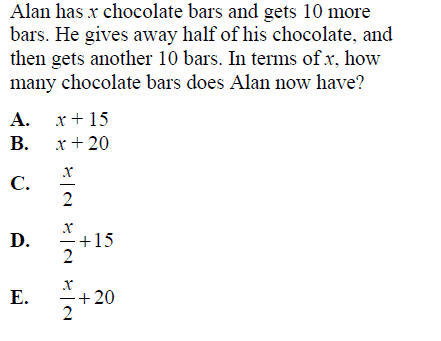If you’re anything like my past teenage self, you may not consider yourself to be a “math person.” Your grades in math may be decent, but mathematical concepts just don’t seem to fully click. Standardized tests, then, can seem all the more intimidating since so many different topics can be covered (algebra, geometry, advanced math—oh my!).
Today we’ll be covering a strategy that is the closest thing you’ll get to a cheat code on ACT or SAT Math. This approach, called “plugging in,” is a way to convert many types of difficult problems into simple arithmetic.
Plugging In: A Guide
Let’s look at an example of a math problem that could appear on either the ACT or SAT:

Alan here is playing fast and loose with his chocolate stash, and with all these different steps, it can be difficult to wrap your mind around what’s happening mathematically. Bringing variables into the mix adds yet another level of difficulty.
But what if I told you there is a way to make this problem ridiculously easy?
Rather than attempting to conceptualize algebraically and write out an equation, let’s just imagine our own hypothetical scenario in which Alan starts with, say, 2 chocolate bars (this means that x=2). Why 2? No reason other than that it’s a small, easy number to work with. Let’s walk through the problem step by step and see what happens next.
So Alan starts with 2 bars and gets 10 more. He now has 12 bars.
Next, he gives away half of his chocolate. Half of 12 bars is 6 bars.
At the end of the problem, Alan gets another 10 bars. 6 plus 10 is 16, and this is Alan’s final chocolate bar count.
Now we’ll look at our answer choices. Each choice contains a variable (x), and we can check each one by substituting 2 for x. We’ll then apply the process of elimination, crossing off any choices that don’t equal 16 (i.e. Alan’s final number of chocolate bars).
Let’s start with choice A: 2+15=17 (Not 16—cross this off!)
Choice B: 2+20=22 (Nope)
Choice C: 2/2=1 (Wrong-o)
Choice D: 2/2+15=16 (It’s a match!)
Choice E: 2/2+20=21 (No dice, so we know that D is our answer)
By testing out a number that we’ve made up, we turned this somewhat abstract algebra problem into straightforward arithmetic and eliminated the need to write out an equation at all!
*mic drop*
Some Additional Considerations
- When plugging in, choose numbers that make the math as simple as possible (preferably something you can do in your head). For example, 2 is generally a much better number to plug in than 37 is.
- Make sure to test out all the answers before moving on—sometimes a number can work with more than one answer choice (look back at our sample problem—if we had decided that x=0, choice A and choice D both would seem correct). Should this happen, you’ll have to pick another and try again! You can reduce the likelihood of getting multiple matches by avoiding numbers like 0 and 1 when plugging in.
- Not every problem can be solved using plugging in. Phrases like “in terms of” or variables in the answer choices are clues that plugging in may be a good option!
Final Thoughts
Sure, in a perfect world, you’d be able to quickly and efficiently apply principles of algebra and geometry to solve upper-level math problems on the SAT or ACT. But in the cutthroat realm of standardized testing, you’ll need to use all the tools in your arsenal to claim as many points as you can. So know your weaknesses and think on your feet as you search for the path of least resistance between you and the answer—plugging in might just be the best strategy to get you where you’re going!
Want to learn even more about plugging in and how it can get you a higher math score? Schedule a call with a Student Success Advisor and get started with your test prep today!

